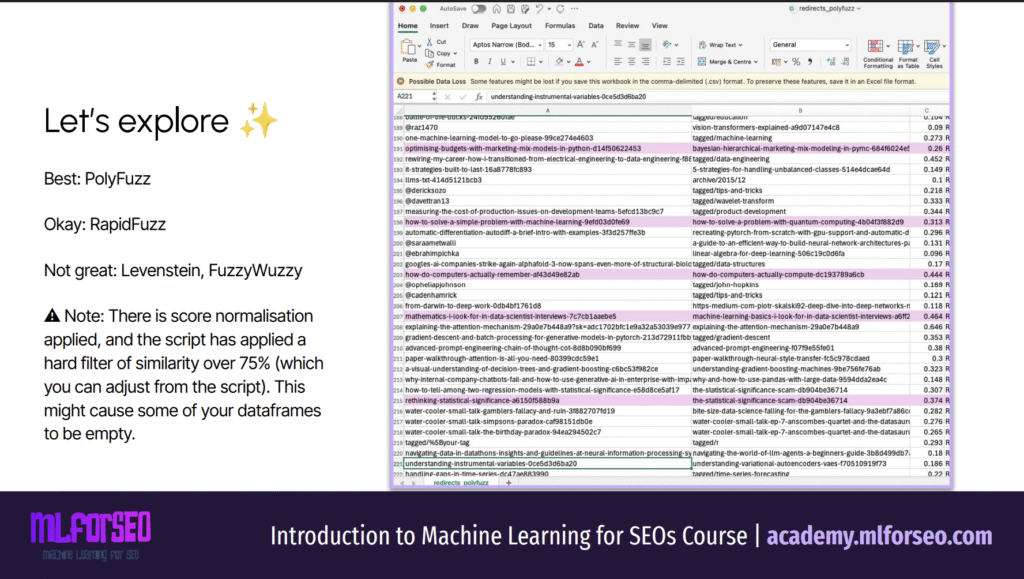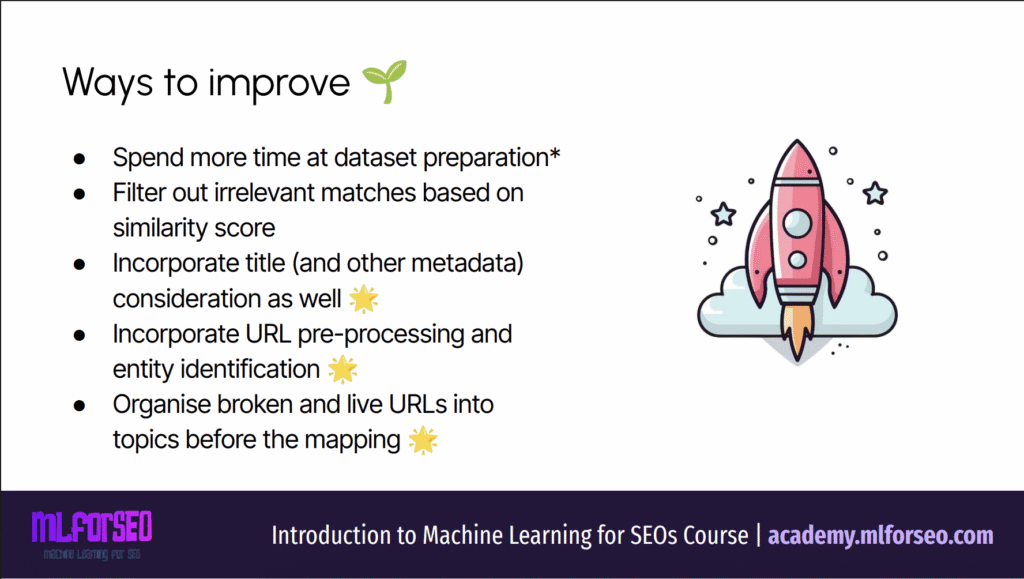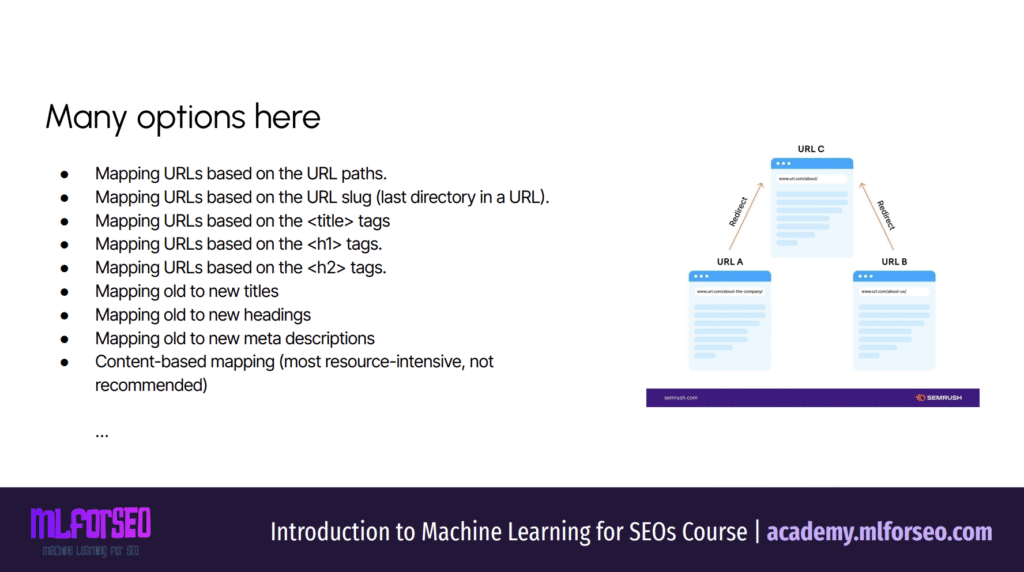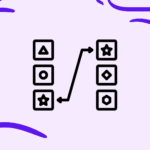Your cart is currently empty!
Different ways to Map Keywords to topics – with Supervised and Unsupervised ML approaches
New course by Beatrice Gamba: AI Search & LLMs: Entity SEO and Knowledge Graph Strategies for Brands now live -> Start learning today ✨

When managing a website, especially after a migration or extensive content pruning, it’s common to end up with hundreds or even thousands of 404 errors (broken pages). I’ve found that redirect mapping is a lifesaver, but it gets tricky when URLs don’t match perfectly. Handling these manually is tedious, but with some Python can automate this process effectively using the machine learning approach of string matching or otherwise known as fuzzy matching.
This tutorial will show you two very similar to one another use cases of fuzzy matching:
If you’d like to learn more about fuzzy matching and string matching, my course Introduction to Machine Learning for SEOs, includes an entire module on these approaches, algorithms, and marketing and SEO project implementations, and use cases.
Go beyond free tools—enroll now and master ML-enabled organic marketing
BEGINNER-FRIENDLY COURSE TO UNDERSTAND AI AND ML
This course offers a step-by-step introduction to machine learning tailored for SEO professionals. Learn how to improve your processes using AI/ML, including automating tasks, analyzing large data sets, and improving content strategies. Perfect for SEOs seeking a competitive edge but also to really understand the nuts and bolts of ML.
404 errors and redirect mapping are central to maintaining a functional and user-friendly website. Understanding their purpose and connection can streamline your efforts in managing broken links effectively.
404 errors occur when a requested URL cannot be found on the server. These indicate that a page is missing or the link used to access it is incorrect. For instance, users may see a “Page Not Found” message after clicking on outdated links or mistyped URLs. Search engines may penalize websites with excessive 404 errors because they impact user experience negatively.
Redirect mapping ensures users and search engines reach alternative relevant pages when encountering broken links. This helps retain site traffic that would otherwise be lost due to missing pages. For example, redirecting an outdated blog post to a similar updated article improves engagement and reduces bounce rates. Proper mapping also protects your site’s SEO performance by preserving link equity and avoiding disruptions in user navigation.
Fuzzy matching finds similarity between imperfect or inconsistent data sets, such as mistyped URLs or varied naming conventions. In redirect mapping, this technique identifies potential alternative pages to replace broken ones. For example, fuzzy matching can link “/product123” and “/product-123” despite their minor differences. Using fuzzy matching in Google Colab simplifies URL analysis and decision-making, enabling efficient resolution of 404 errors with computational tools.
The beauty of fuzzy matching is that it’s:
Grab a copy of the featured Python Scripts from this blog post:

/how-do-computers-actually-remember ↔ /how-do-computers-actually-compute/mathematics-i-would-look-for-in-data-science-interviews ↔ /machine-learning-basics-i-would-look-for-in-data-science-interviews
Tune thresholds per group.
Blog posts, product pages, and docs may need different similarity cutoffs. Calibrate per cluster for cleaner results.
Invest in dataset prep.
Remove authors, tags, categories, or other templates if you plan to handle them differently from content pages. Group 404s by handling strategy before you run matching.
Add metadata into the matching.
Incorporate titles (and available metadata) alongside slugs for better signals.
Pre-process slugs + identify entities.
Parse slugs, extract tokens, and run entity recognition on slugs/titles.
Then cluster both broken and live URLs by topic/entity and match within clusters. This injects lightweight “semantic” structure without heavy ML.
A migration happened. You have pre-migration and post-migration crawls, and now you want a fast, auditable map from old to new.

Grab a copy of the featured Python Scripts from this blog post:
Applying specific strategies can improve both accuracy and efficiency when implementing redirect mapping with fuzzy matching techniques.
Adjusting fuzzy matching ratios is essential for balancing precision and flexibility in URL comparisons.
I test multiple thresholds based on dataset characteristics and use the similarity scores provided by FuzzyWuzzy’s fuzz or process modules to determine optimal values.
Resolving duplicate or ambiguous matches reduces errors in redirect suggestions. When multiple potential matches occur for a single 404 URL, I sort them by their similarity scores in descending order.
Priority is given to URLs with higher scores or those aligning with site-specific rules, such as matching keywords in page titles. Using a Pandas DataFrame, I filter and preprocess the results to ensure clarity, selecting only the top-ranked match or confirming correct associations manually if required.
Minimizing false positives ensures reliable redirections. I incorporate validation checks, such as verifying that suggested redirects are live and relevant to user intent, by using the Requests library to confirm HTTP status codes (e.g., 200). Custom filters exclude short-lived matches or redirects leading to the same 404 error, improving dataset reliability.
Adding a manual review step for flagged URLs enhances the process when automated methods fail to meet accuracy expectations.
While implementing 404 and redirect mapping with fuzzy matching in Google Colab, challenges may arise that disrupt the process. Addressing these issues promptly ensures a smoother workflow and more accurate outcomes.
Performance challenges often occur when processing large datasets in Google Colab. For optimization, I reduce the dataset size by filtering irrelevant URLs before analysis, ensuring only actionable data remains. Increasing Google Colab’s RAM allocation through the notebook environment settings addresses memory limitations when needed.
When runtime restrictions interfere, you can also:
Incorrect redirect suggestions sometimes stem from suboptimal fuzzy matching configurations. To resolve this, I adjust the similarity ratio threshold in FuzzyWuzzy; lowering it captures more possible matches, whereas increasing it improves precision.
If mismatched URLs persist, I include contextual rules for prioritizing keyword relevance or path patterns during comparisons. You can also use something like entity matching on the titles, URLs, or content itself, or comparing the overall similarity scores of scraped pages, to increase the mapping precision.
Never skip out on manual review steps for flagged outputs.
I also wanted to highlight some alternative methods of handling 404 errors and broken links, offering expanded options for redirect mapping:
If you’re dealing with >1,000 URLs, move to Colab/Python. You’ll get control over libraries, algorithms, data access, and output — and avoid UI ceilings.
Fuzzy matching speeds up 404 and migration mapping, improving UX and protecting SEO by resolving broken journeys quickly.
Google Colab + Python libraries (PolyFuzz, RapidFuzz, FuzzyWuzzy, Levenshtein) provide a flexible, replicable workflow.
Threshold tuning, smart pre-processing, and human QA make or break quality.
Entity-aware clustering and metadata matching boost precision without heavy ML.
For small datasets, no-code options are fine; for larger ones, use Colab for control and scale.
Now that you’ve seen how to apply fuzzy matching to 404s and migration redirects, I also want to highlight more MLforSEO content where we use string matching for different SEO and marketing use cases. If you want the end-to-end playbook — algorithms, templates, and 20+ project ideas you can implement this technique in — join Introduction to Machine Learning for SEOs.
Managing 404 errors and implementing effective redirect mapping is essential for maintaining a seamless user experience and protecting SEO performance.
Here’s a short summary on the key takeaways from this piece:
Now that you know how to work with fuzzy matching algorithms, I also want to highlight other MLforSEO content we have that uses string matching for different use cases.
Different ways to Map Keywords to topics – with Supervised and Unsupervised ML approaches
How to Automatically Optimize your SEO Metadata with FuzzyWuzzy and OpenAI in Google Colab
Lazarina Stoy is a Digital Marketing Consultant with expertise in SEO, Machine Learning, and Data Science, and the founder of MLforSEO. Lazarina’s expertise lies in integrating marketing and technology to improve organic visibility strategies and implement process automation.
A University of Strathclyde alumna, her work spans across sectors like B2B, SaaS, and big tech, with notable projects for AWS, Extreme Networks, neo4j, Skyscanner, and other enterprises.
Lazarina champions marketing automation, by creating resources for SEO professionals and speaking at industry events globally on the significance of automation and machine learning in digital marketing. Her contributions to the field are recognized in publications like Search Engine Land, Wix, and Moz, to name a few.
As a mentor on GrowthMentor and a guest lecturer at the University of Strathclyde, Lazarina dedicates her efforts to education and empowerment within the industry.







Beginner BERTopic FuzzyWuzzy Google Autocomplete API Google Cloud Natural Language API Google Colab (Python) Google Sheets (Apps Script) Intermediate KeyBERT kMeans OpenAI API sBERT Whisper API
Share this post on social media:
Leave a Reply